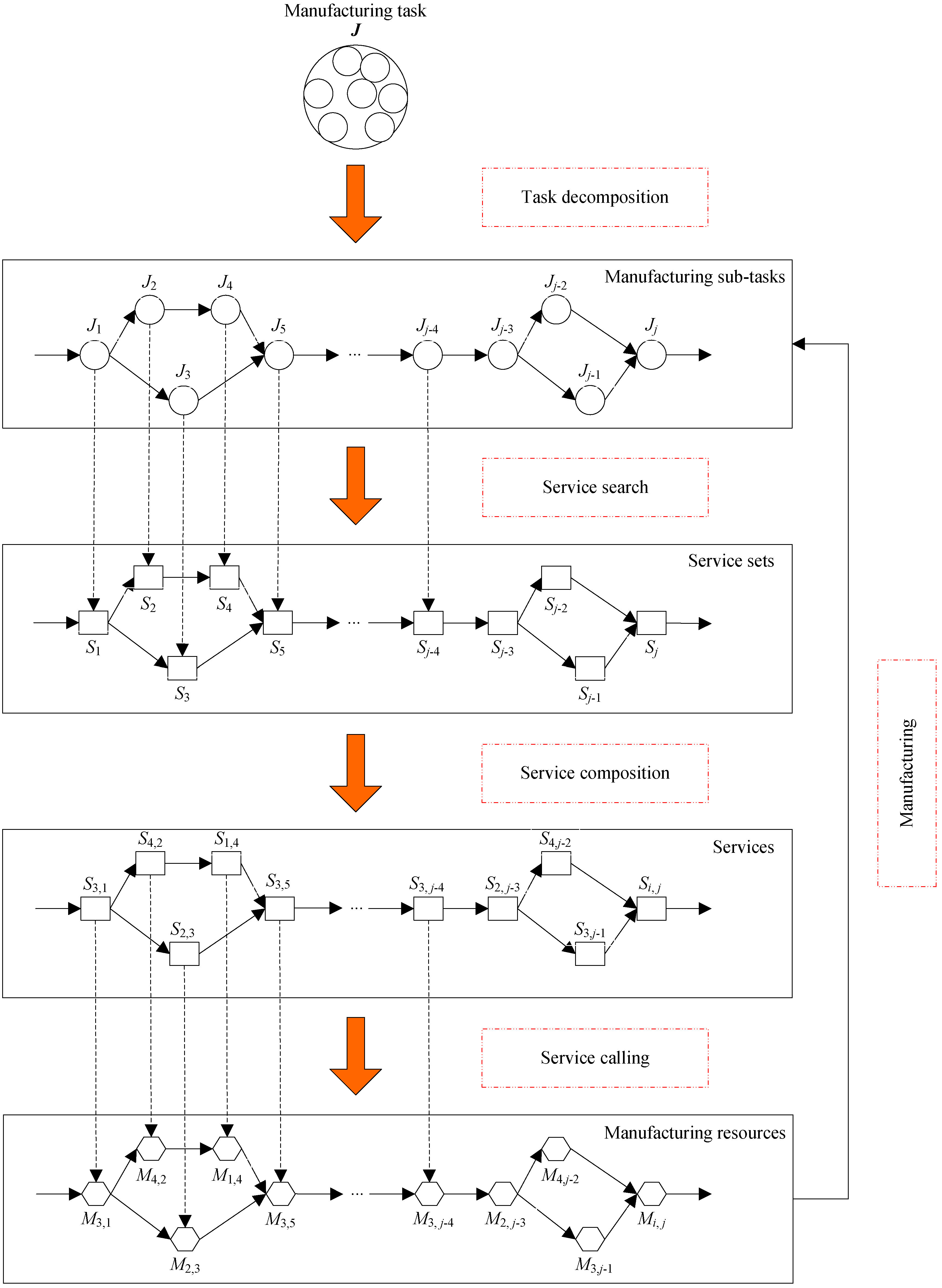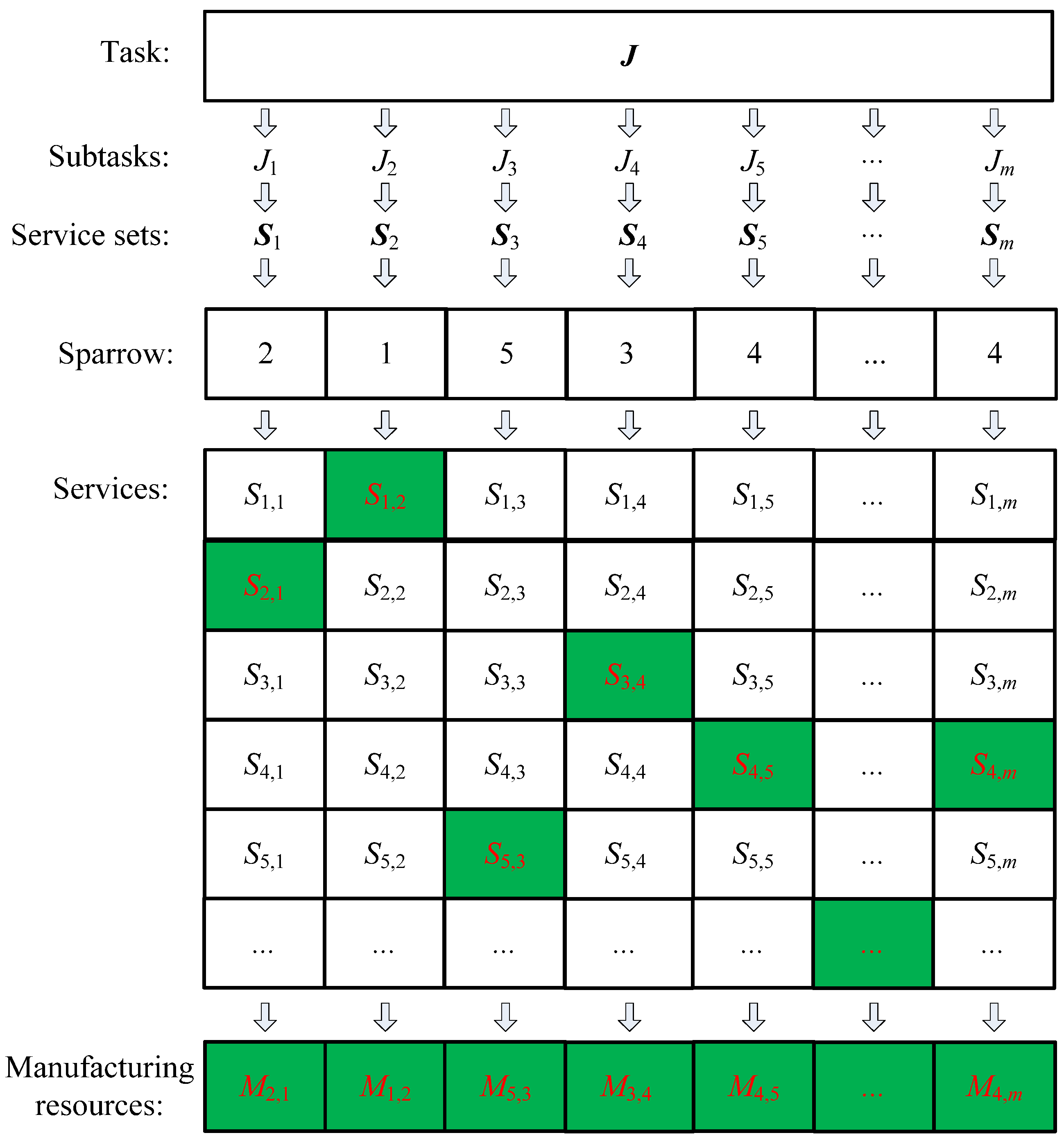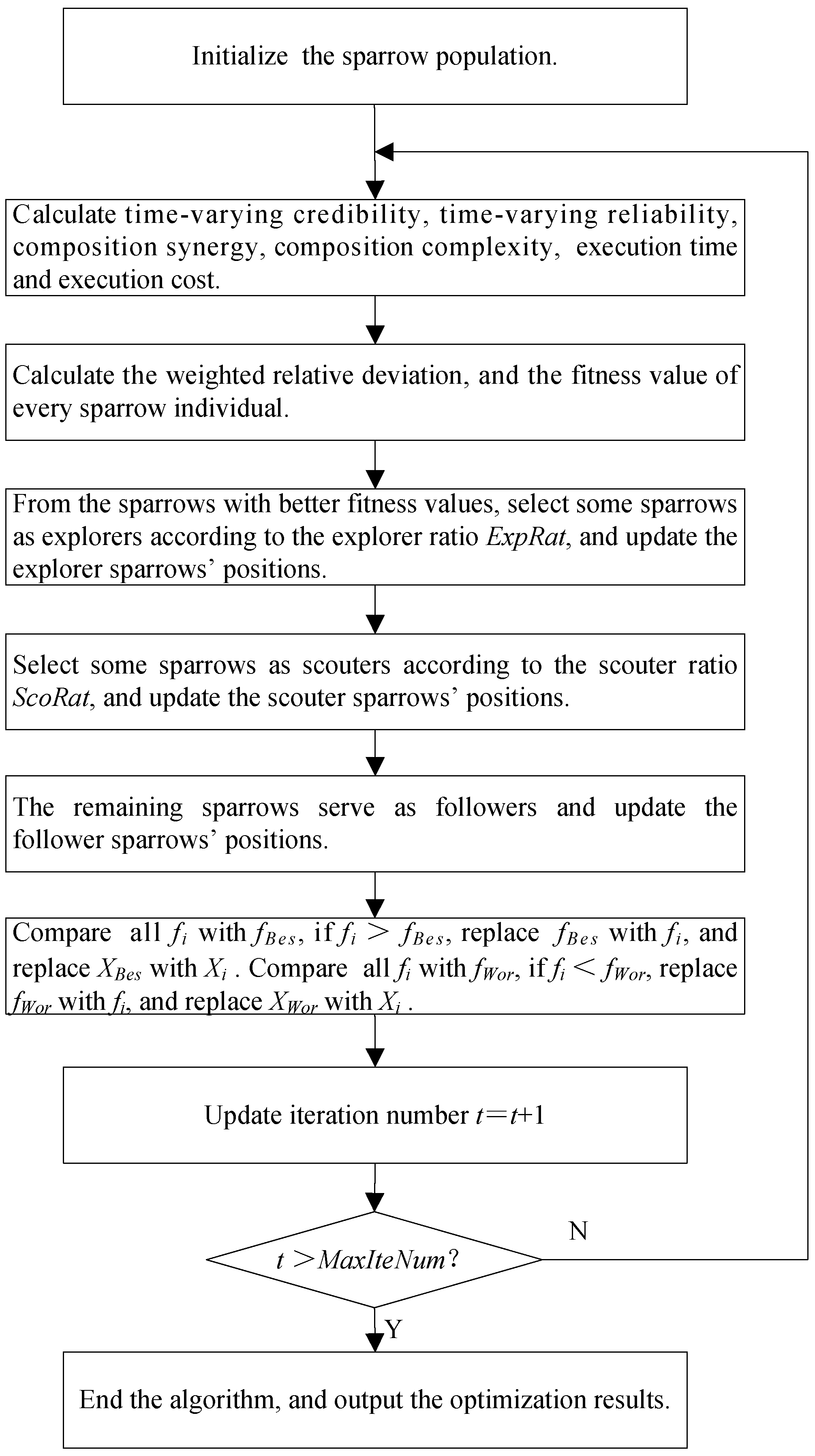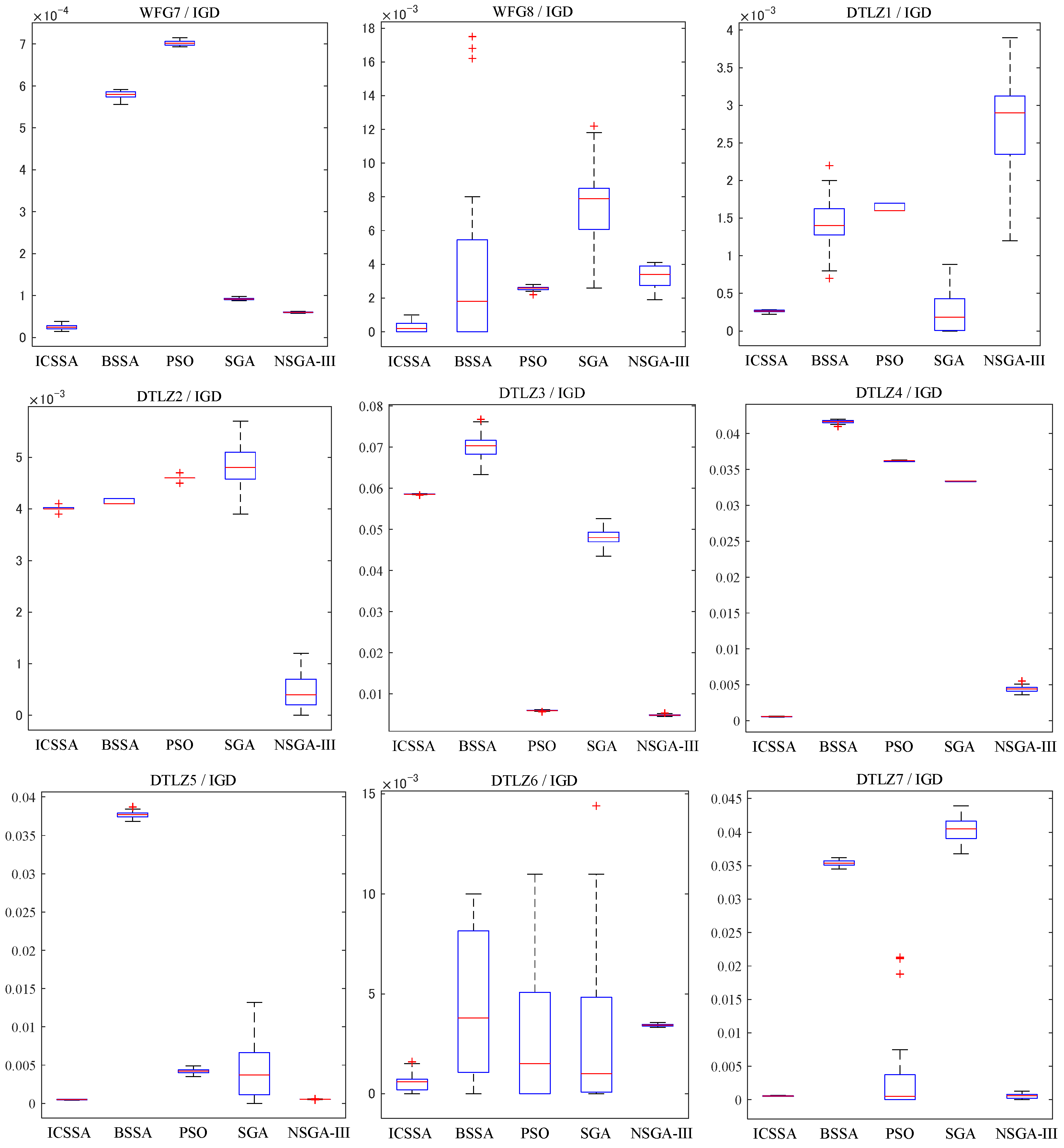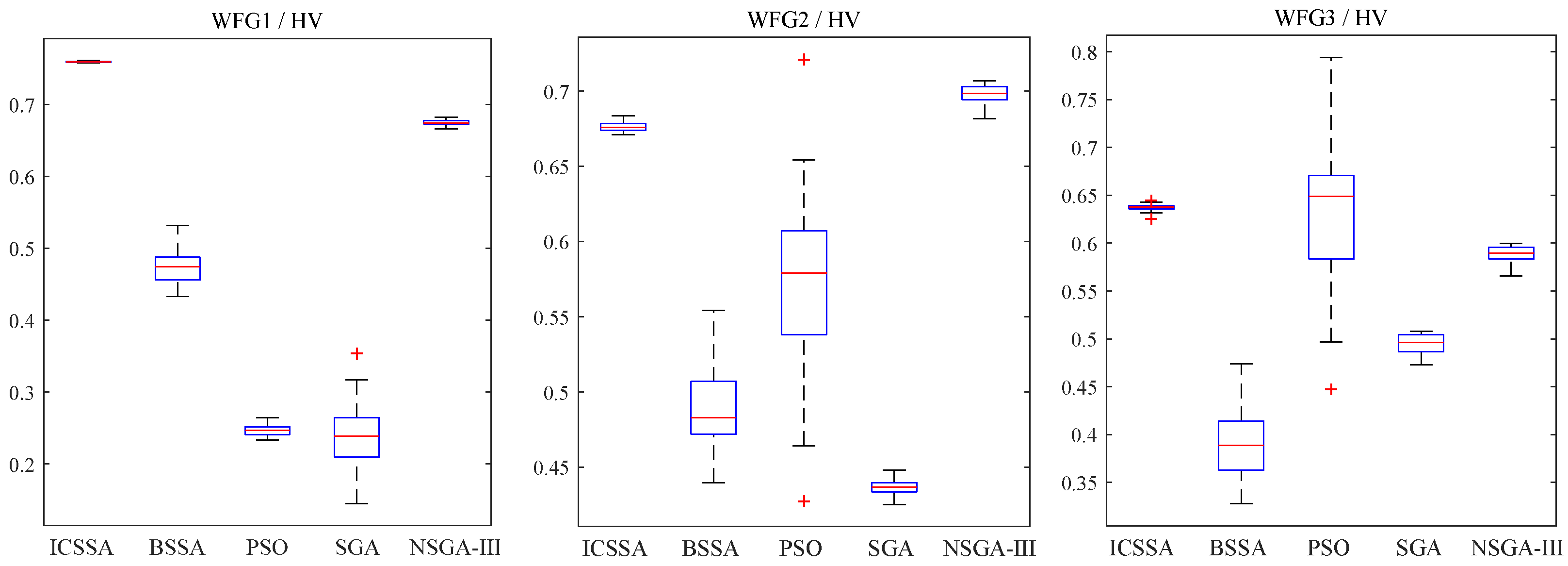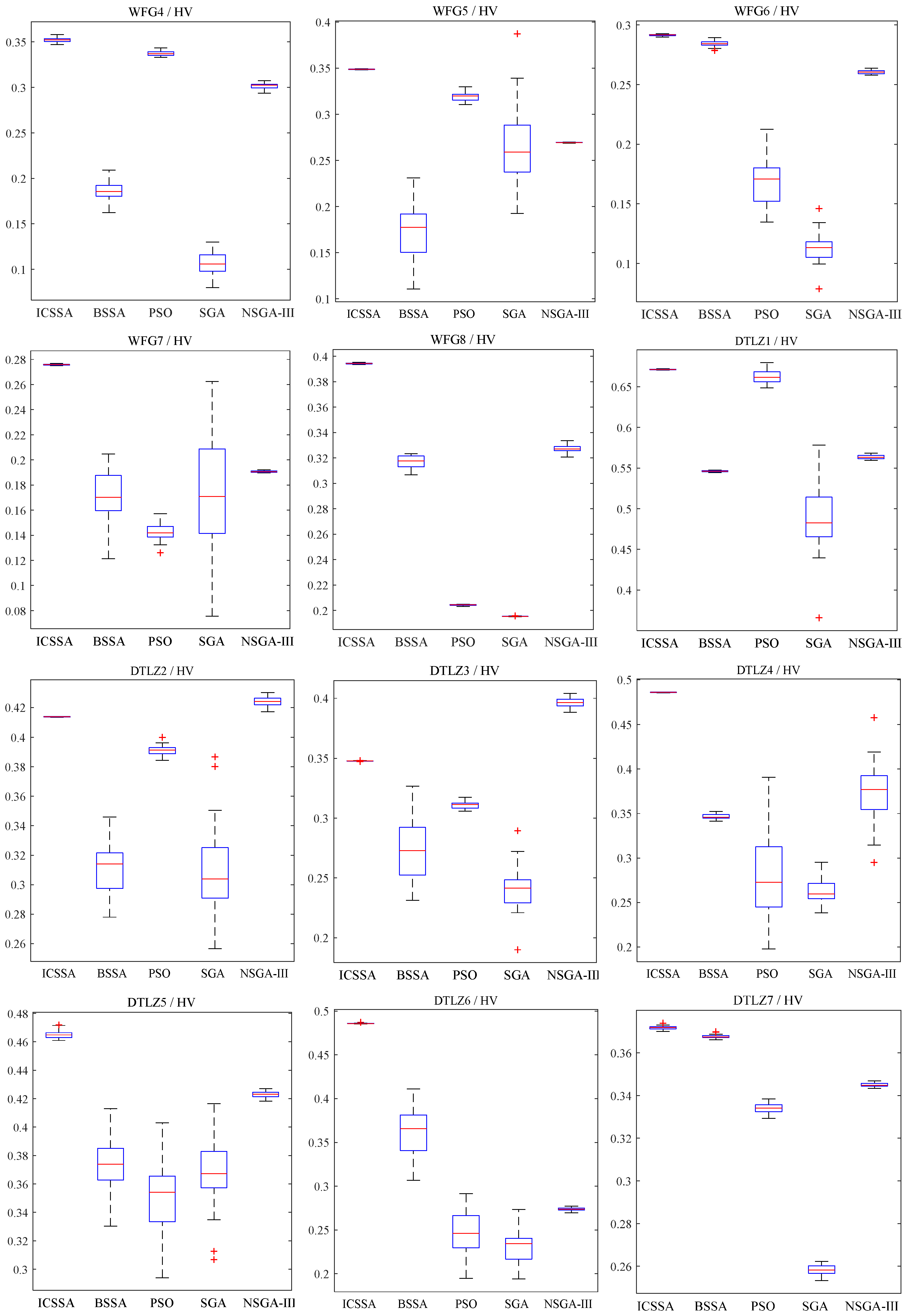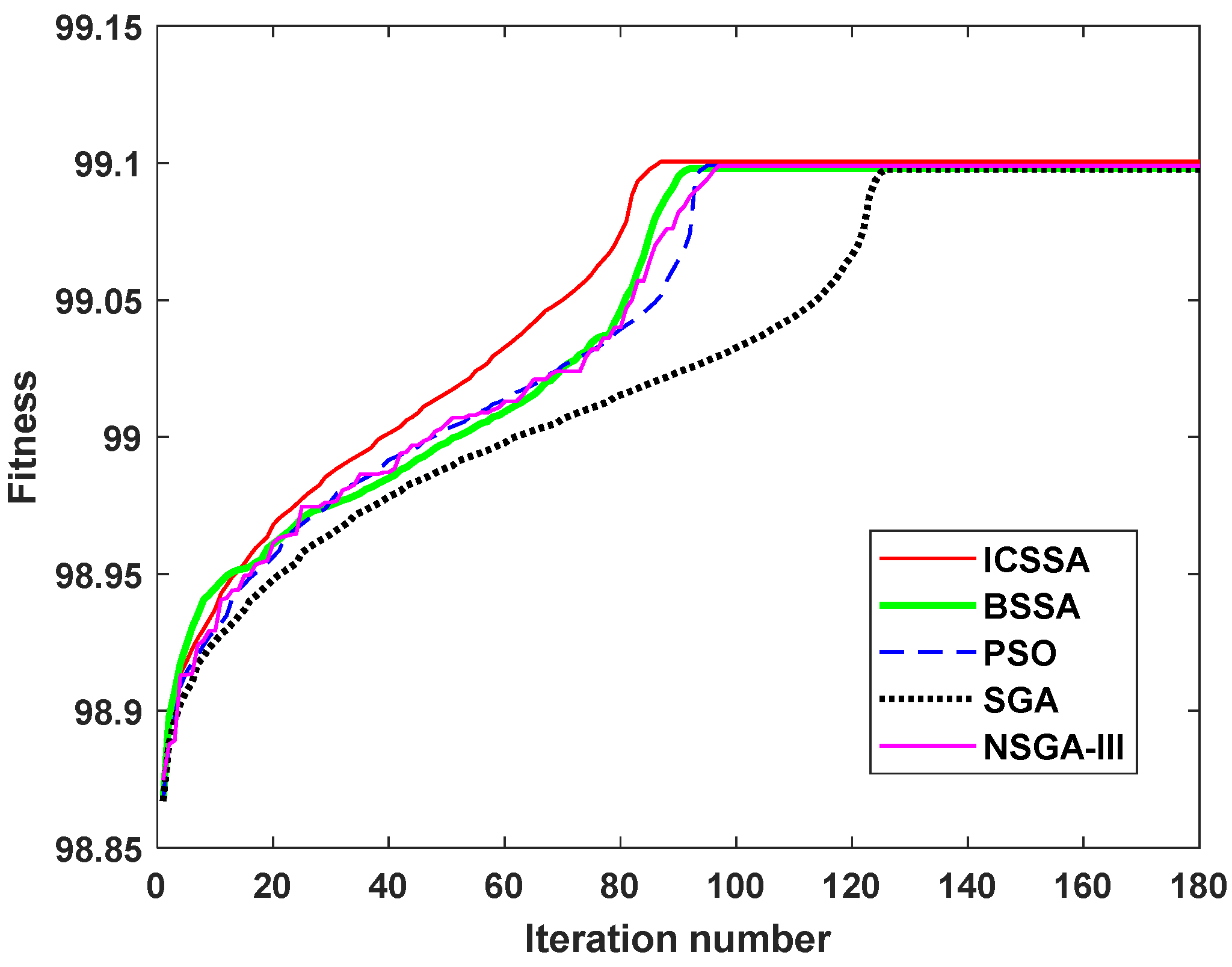1. Introduction
Over the past half-century, the global economy has demonstrated that openness, collaboration, and innovation hold the key to advancing manufacturing and economic growth. The disruptive influence of volatile factors, such as trade frictions, has significantly impacted the open and collaborative landscape, thereby slowing the pace of development in the global manufacturing industry. Currently, businesses are placing a heightened emphasis on the reliability of manufacturing supply chains [
1]. Consequently, numerous nations have prioritized the establishment of highly trustworthy and dependable manufacturing supply chains and services at the national decision-making level. Cloud manufacturing (CMfg), a service-centered manufacturing approach, aligns with the evolving needs of the manufacturing industry in the contemporary era [
2]. It offers a viable solution to address the challenges posed by diverse consumer demands and shortened product market cycles [
3]. The CMfg service platform virtualizes and offers manufacturing resources and capabilities, enabling centralized oversight of distributed manufacturing assets and tailored services to a diverse user community [
4]. In the intricate and dynamically evolving international landscape, an analysis of time-varying reliability and credibility offers enhanced insights for CMfg service selection and user decision-making.
The construction of the CMfg service composition (SvcComp) model, along with its associated solution algorithm, serves as a crucial element in determining the effectiveness of the optimal SvcComp plan. Furthermore, it significantly impacts the efficiency and profitability of CMfg resources. The optimization of CMfg SvcComp is characterized by its multi-objective nature, nonlinearity, and inherent uncertainty. Consequently, numerous scholars are devoting themselves to addressing the intricate NP problem [
5]. Scholars primarily focus on production cost, execution time, and profit as key optimization parameters in their exploration of SvcComp modeling and optimization algorithms. However, they infrequently take into account the influence of non-functional service quality factors, including service reliability, reputation, and composition synergy, on the overall SvcComp. The execution of CMfg entails a collaborative effort involving various distributed manufacturing resources. Notably, each CMfg service execution agent operates within a specific natural and social context, deviating from the idealized perception of a “rigid body”. Within the CMfg process, diverse CMfg services engage in data exchange, information transmission, and material transportation. The interactions give rise to constraints, collaborations, and competitions that persist throughout the entire manufacturing lifecycle. The interplay among services and tasks, among services themselves, and with agents occupies a vital position in determining the effectiveness and efficiency of SvcComp in executing manufacturing tasks. Instances such as war friction and the Red Sea crisis highlight the significance of manufacturing enterprises being deeply embedded in the global industrial chain to leverage both service credibility and reliability alongside manufacturing cost and time as key metrics for assessing CMfg service quality. This approach ensures the provision of more credible, reliable, and efficient services to users. In the intricate and dynamic international landscape, the time-varying nature of reliability and credibility significantly influences the overall performance and service selection within CMfg SvcComp. The CMfg environment necessitates the collaborative efforts of various executing agents, encompassing service providers, operators, customers, and more. The collaboration is influenced by both natural and social factors. The reliability of CMfg services, the degree of collaboration among services during the manufacturing process, the credibility of these services, and the complexity of the SvcComp all play crucial roles in the successful accomplishment of manufacturing endeavors. Therefore, while adhering to the constraints of delivery time and manufacturing cost, it is imperative to optimize CMfg SvcComp by prioritizing parameters such as service reliability, composition synergy, service credibility, and composition complexity.
The fundamental principle of SvcComp dictates that all manufacturing tasks stemming from the decomposition of manufacturing demands must be assigned to either a single cloud service or multiple cloud services for execution. The optimal CMfg SvcComp scheme should exhibit optimal overall performance, encompassing maximum service reliability, composition synergy, and service credibility, while minimizing composition complexity, delivery time, and manufacturing cost. The key contributions of this work are outlined as follows: (1) an improved chaos sparrow search algorithm tailored for CMfg SvcComp is introduced; (2) a CMfg SvcComp optimization model, incorporating factors such as time-varying reliability, time-varying credibility, and composition complexity, is developed; (3) an illustrative application example is presented to demonstrate the effectiveness of the proposed mathematical model and optimization algorithm.
The rest of this paper is structured as follows:
Section 2 conducts a comprehensive analysis of domestic and international research on service reliability, service credibility, CMfg SvcComp, and its associated optimization algorithms.
Section 3 defines and outlines the calculation methods for time-varying reliability, composition synergy, time-varying credibility, composition complexity, execution time, and execution cost.
Section 4 introduces an improved algorithm, while
Section 5 validates the effectiveness of the proposed method through a detailed analysis of practical applications. Finally,
Section 6 concludes this paper and underscores the significance of the work.
2. Related Work
In recent years, various scholars have delved into the modeling and optimization of cloud SvcComp, leveraging techniques such as genetic algorithms and particle swarm optimization. By synthesizing the prior research efforts of these scholars, we meticulously selected the most pertinent studies and categorized the existing research into three distinct groups.
The first group studied service reliability and service credibility. In the research of service credibility, Qiu-yun Zhao et al. [
6] put forward a support mechanism for credibility in CMfg services, which hinged on a classified approach to QoS, described the environment information and the level of QoS in the manufacturing cloud service model, and constructed an adaptive control logic algorithm to adjust the QoS level. Tooba Aamir et al. proposed a credibility model of social sensor cloud service based on user’s position and credibility. It used comments and metadata of cloud service to collect the trust rate of the service and the credibility of the users’ comments [
7]. R. Tang et al. proposed an algorithm of cloud media resource allocation based on credibility, which allocated cloud media resources based on total credibility to obtain the optimal allocation sequence of higher allocation efficiency and service quality [
8]. Suzhen Wang et al. proposed a trust management model based on credibility, which could distinguish trust feedback and detect malicious trust feedback of attackers [
9]. Lie Qu et al. proposed a new model for evaluating the reliability of users, which provided subjective evaluation by ordinary cloud consumers and objective evaluation by professional testers for cloud services, and could resist user collusion [
10]. Xiaogang Cai et al. proposed a method of evaluating and modifying reputation based on node credibility [
11]. By calculating the reputation of each node and modifying the reputation value, the accuracy of reputation results was improved, and an incentive mechanism was introduced to improve the enthusiasm of cloud user node evaluation. Khamdi Mubarok et al. proposed a hierarchical model for reliability assessment, specifically designed to evaluate the dependability of manufacturing services. In this model, enterprise manufacturing resources were categorized into three distinct levels, component, machine, and system, enabling a comprehensive reliability evaluation [
12]. Combining explicit text information with rating information and implicit context information, Jian Liu et al. determined task similarity and employed a clustering-based approach to identify cohorts of users sharing similar characteristics [
13]. They further devised a trust perception methodology that merged both local and global trust metrics, reconstructing the trust network among clustered users. Additionally, they introduced a prediction and recommendation strategy for service quality, grounded in clustering and trust perception principles. Shikai Jing et al. put forward an SvcComp approach for CMfg, leveraging discrete particle swarm optimization with a focus on execution reliability [
14]. The probability density function was used to describe the service reliability, and the CMfg SvcComp workflow model was dynamically generated based on the service model library. Chen Jiang et al. proposed a real-time estimation error-guided sampling method for time-varying reliability analysis, used Kriging prediction mean and variance to calculate the probability of error classification, obtained the total number of error classification points, and calculated the estimation error of fault probability based on confidence intervals [
15]. Junejo A.K. et al. studied a cloud service trust computing framework that calculates credibility by aggregating multidimensional evidence of quality of service and quality of experience [
16]. The approach integrated the principles of complex networks to provide a comprehensive assessment of accounting cloud service reliability. Zhiqiang Wan et al. analyzed the problem of the monotonic degradation of materials and time-varying reliability evaluation of parametric random loads, and proposed a new method combining the probability density evolution method and probability measure change [
17]. Hua-Ming Qian et al. introduced a decoupling technique for single-loop processes, alongside a double-closed-loop Kriging model, specifically tailored for time-varying reliability analysis [
18]. Hong-Shuang Li et al. proposed a high-dimensional time-varying reliability analysis method that incorporated random sampling and treated random processes as inputs [
19]. The time-varying reliability analysis was transformed into the reliability problem of series systems with multiple responses. M.H. Ping et al. proposed a time-varying extreme event evolution method and simulated the time evolution process of extreme events by the time-dependent polynomial chaotic expansion method [
20]. Monte Carlo simulation was used to sample the standard normal variables, and the time-varying reliability of the failure threshold was obtained.
The second group delved into the intricacies of manufacturing task decomposition and SvcComp. Mingzhou Liu et al. introduced a CMfg task decomposition algorithm that employed sequential task decomposition, leveraging a recursive decomposition approach to enhance the optimization of decomposed tasks [
21]. Aijun Liu et al. developed a quantitative analysis technique for task granularity, which assessed the granularity of complex product collaborative workflows within integrated manufacturing systems [
22]. The method served as a guide for coarse-grained task decomposition and the reorganization of sub-tasks with low cohesion coefficients. Shuping Yi et al. proposed a task decomposition optimization strategy grounded in clustering algorithms [
23]. By reconstructing decomposed sub-tasks using clustering techniques, they achieved optimal task decomposition and offered a solution to the disjoint issue that arose in manufacturing task decomposition and resource allocation. Katz Dmitriy et al. investigated two variations of the classic job interval scheduling problem, focusing on the flexible allocation of reusable resources among competing job intervals [
24]. J. Thekinen et al. examined the objectives and preferences of service seekers and providers in cloud-based design and manufacturing [
25]. They further evaluated the suitability of various matching mechanisms in the context of cloud design and manufacturing. Octavian Morariu et al. explored service-oriented approaches for enhancing resource allocation in a private cloud environment [
26]. They introduced an extended queued resource allocation bus architecture that incorporated the computation of alternative schedules for optimized resource utilization. Yang-Kuei Lin et al. proposed a resource-constrained project scheduling method based on a genetic algorithm, which integrated novel concepts like enhancement and local search, addressing the challenges associated with computing resource allocation in cloud computing systems [
27]. Buyun Sheng et al. delved into the complexities of the matching process between an intelligent matching engine and CMfg services, emphasizing their diversity, heterogeneity, and multi-constraints [
28]. They developed an intelligent search engine tailored for small and medium-sized enterprises’ CMfg services, leveraging service ontology language to facilitate swift and efficient cloud search matching. Fei Tao et al. introduced a supply–demand matching simulator specifically for manufacturing services, outlining a simulator architecture grounded in hyper-networks [
29]. Jinhui Zhao et al. proposed a bilateral matching model for cloud services, emphasizing the role of quality of service in the matching process [
30]. It calculated satisfaction degree by the variable fuzzy identification method. Yuqian Lu et al. delved into the realm of knowledge-based SvcComp and adaptive resource planning within the CMfg environment [
31]. They constructed an integrated network environment that could swiftly allocate resources for specific service requests, leveraging governance strategies, resource access mechanisms, and availability information. Jorick Lartigau et al. recognized the commonalities among cloud services, including QoS parameters, but broadened their focus to include the physical locale of manufacturing resources [
32]. They introduced a methodology that combines QoS evaluation with geo-perspective correlation across cloud services, enabling a comprehensive analysis of transportation impacts. Marcos A. Pisching et al. studied the characteristics and major challenges of industrial 4.0 SvcComp based on CMfg [
33]. Yan Xiao et al. introduced a decision-making framework for manufacturing service resource matching, emphasizing the fusion of multidimensional information [
34]. Leveraging the integration of various information data sources from CMfg resources, they categorized the significance of manufacturing service tasks using information entropy and rough set theory. Hamed Bouzary et al. proposed a hybrid algorithm which combines the
grey wolf optimization algorithm and the genetic algorithm [
35]. The embedded crossover and mutation operators enabled the continuous structure of the grey wolf algorithm to adapt to combinatorial problems such as SvcComp optimization selection. Mohammad Moein Fazeli et al. proposed an integrated optimization method for choosing the best composition of services to execute customer requests [
36].
The third group focused on service quality evaluation and optimization algorithms. K. He et al. [
37] outlined selection criteria for CMfg service providers within the CMfg system and developed a comprehensive evaluation index system incorporating a scalable quantitative model. The triangular fuzzy number algorithm was used to calculate the similarity and demand expectation between service providers, and the comprehensive performance ranking of service quality was obtained. Shangguang Wang et al. proposed an accurate evaluation method of cloud service quality [
38]. According to the preferences of cloud users, a fuzzy comprehensive decision method was used to evaluate cloud service providers. Xinggang Wang et al. proposed a task evaluation index system for 3D printing orders for innovative new product development in a CMfg environment [
39]. The evaluation index included eight dimensions: execution time, service quality, matching, reliability, flexibility, cost, fault tolerance, and satisfaction. Yuan Ye et al. proposed an evaluation system of e-government service quality for telecom operators and evaluated the service quality based on network factors, service process factors, collaboration factors, and resource allocation factors [
40]. Yanjuan H et al. delved into the challenges of manufacturer scheduling within the CMfg environment [
41]. They thoroughly analyzed the influencing factors of manufacturer resource scheduling, encompassing task load, task reliability, manufacturing efficiency, resource abundance, and IoT matching. Utilizing a chaotic optimization algorithm, they addressed the objective function, successfully realizing manufacturer scheduling across various tasks. Yongxiang Li et al. introduced a CMfg SvcComp optimization approach leveraging cloud entropy-enhanced genetic algorithms [
42]. They outlined methods for computing service matching, composition coordination, and cloud entropy, establishing a multi-objective optimization model for CMfg SvcComp. Wenjun Xu et al. proposed an enhanced Pareto-based discrete bees algorithm, aiming to select optimal services from a vast array of CMfg offerings, combining them to create new, high-performance services [
43]. Onaizah N A and Aljanabi R M presented a novel approach, the chaotic African vulture optimization algorithm integrated with a deep learning-driven solid waste classification system, termed CAVOA-DLSWC. Its objective was to automatically identify waste objects and categorize them into distinct groups utilizing advanced deep learning models [
44]. M. Tavana et al. introduced a discrete cuckoo optimization algorithm, leveraging group technology for seamless resource allocation integration [
45]. Fateh Seghir et al. proposed a hybrid genetic algorithm specifically tailored to address the cloud SvcComp challenge, with a focus on quality of service perception [
46]. It combined the genetic algorithm and drosophila optimization to search the evolutionary process. Xianmin Wei et al. studied the optimal resource allocation for CMfg. Utilizing a four-dimensional objective function encompassing time, cost, quality of service, and load balancing, an ant colony algorithm was employed to discover the optimal solution [
47]. Yi Que et al. introduced a user-centered manufacturing model for the manufacturer cloud, developing a comprehensive mathematical evaluation framework that encompassed four crucial service quality perception metrics: time, reliability, cost, and capability [
48]. They further proposed an information entropy-based immune genetic algorithm to enhance the selection of core manufacturing SvcComps. Hui Jiang et al. developed a multi-objective genetic algorithm grounded in non-dominated sorting techniques to tackle the disassembly SvcComp optimization challenge [
49]. Their study focused on cloud-based disassembly systems, offering disassembly services tailored to user needs. Sergi Vila et al. introduced a multi-objective genetic algorithm to determine the most appropriate allocation of the cloud to available virtual machines [
50]. Tianhua Li et al. introduced a self-learning artificial bee colony genetic algorithm, integrating reinforcement learning techniques. The innovative algorithm intelligently selected feasible solutions for optimizing CMfg SvcComp [
51]. The global optimal individual served as a guiding beacon, enhancing the search accuracy of the algorithm by refining the search equation. Zhongning Wang et al. proposed a novel hybrid algorithm, marrying the bee colony method with the simplex approach [
52]. The algorithm addressed large-scale cloud SvcComp optimization challenges.
The research work of the aforementioned scholars is a microcosm of the rapid development of CMfg SvcComp in recent years. However, in their research on CMfg SvcComp optimization, they did not comprehensively analyze various factors and relationships that affect CMfg service quality from both social and natural aspects. The impact mechanisms of time-varying credibility and time-varying reliability on CMfg SvcComp performance are rarely considered together in their work. The impact of the current unstable international relations on the industrial chain makes it necessary for us to establish a CMfg SvcComp model that is more in line with the development of the times and comprehensive considerations, and devise a more effective optimization algorithm tailored to the purpose.
4. Improved Chaos Sparrow Search Algorithm
The sparrow search algorithm, a novel swarm intelligence optimization method introduced in 2020, simulates the foraging behavior of sparrows. Although it has superior performance, it has made slow progress in addressing the challenges of multi service composition optimization and is prone to local optimization traps. To enhance its performance, the Bernoulli chaotic mapping formula is integrated, and the position calculation formulas for explorer and scouter sparrows are fine-tuned. The improvement boosts the algorithm’s search and development capabilities, leading to superior global optimization results, faster convergence, and shorter runtimes. As a result, a novel and improved approach is provided for tackling multi service composition optimization problems.
4.1. Basic Sparrow Search Algorithm
In the basic sparrow search algorithm (BSSA), a sparrow’s position corresponds to a solution. Different sparrow positions represent different solutions. There are three types of sparrows in the sparrow group, the explorer sparrow, follower sparrow, and scouter sparrow, which correspond to the three behaviors of sparrows when foraging: (1) as an explorer, searching and finding food; (2) as a follower, following the explorer for foraging; and (3) as a scouter, detecting and monitoring predator threats, providing early warning for the sparrow group, and deciding whether to give up the current food.
In the BSSA, the explorer sparrow position formula is given below.
where
represents the updated position of the
j-th dimension of the
i-th explorer sparrow after the
t-th iteration. The algorithm has a predefined maximum iteration count denoted by
MaxIteNum. The variable
is a randomly generated number within the range of (0, 1], ensuring a uniform distribution.
, on the other hand, is a random number drawn from the standard Gaussian distribution within the interval [0, 1]. The matrix
, which consists of all elements equal to 1, is related to
. Additionally,
signifies the total number of dimensions in
. Lastly,
is a randomly chosen number from the range [0, 1], and called the warning value;
is a random number between [0.5, 1], and is called the safety threshold.
The follower sparrow position formula is shown as follows:
where
denotes the globally optimal foraging position attained by the explorer following the (
t + 1)-th iteration. Conversely,
represents the globally poorest foraging position recorded after the
t-th iteration. Furthermore,
comprises a matrix derived from
, with its elements randomly assigned to either 1 or −1, and
. Lastly,
NumSpa signifies the aggregate count of sparrows involved.
The scouter sparrow position formula is given below.
where
represents the globally optimal foraging position achieved after the
t-th iteration.
serves as a step control parameter, a random number drawn from the standard Gaussian distribution within the range [0, 1]. Additionally,
is a uniformly distributed random number between [−1, 1].
,
and
correspond to the fitness of the
i-th sparrow, the global best fitness, and the global worst fitness, respectively. Lastly,
is a minute value that ensures that the denominator of the formula remains nonzero, preventing any division by zero errors.
4.2. Improved Chaos Sparrow Search Algorithm
4.2.1. SvcComp Coding Method
The improved chaos sparrow search algorithm (ICSSA) employs an integer encoding approach to establish a correspondence between the position of sparrows and the SvcComp scheme. In the CMfg environment, customer manufacturing task types include the single-function requirement type and multiple-function requirement type. The single-function requirement manufacturing task can be completed directly by the atomic CMfg service mapping a single manufacturing resource. The complex manufacturing task with multiple functional requirements needs to combine more than two atomic CMfg services. The execution procedure encompasses several key steps: the decomposition of CMfg tasks, matching of cloud services, selection of services, and composition of services. A complex manufacturing task, encompassing multiple functional prerequisites, can be dismantled into
m distinct sub-tasks. Each sub-task is then assigned to a suitable candidate cloud service for execution. Consequently, the SvcComp comprises
m atomic cloud services, collectively fulfilling the complex manufacturing task. In the ICSSA, a cloud SvcComp can be represented by a sparrow, and the sparrow dimension is
m, corresponding to
m atomic cloud services. The
j-th dimension of a sparrow corresponds to the set
Sj of candidate cloud services for the
j-th sub-task
Jj within a complex manufacturing task. The set
Sj encompasses all potential cloud services suitable for executing the task
Jj. The numerical value of the
j-th dimension signifies the specific cloud service chosen to fulfill the
j-th task. Within a sparrow group encompassing
NumSpa sparrows, the spatial location of the
i-th sparrow can be represented by an
m-dimensional vector, as detailed below.
The sparrow group can be represented by a set as outlined below.
where
represents the
j-th dimension of the positional vector associated with the
i-th sparrow. The numerical value of
signifies the specific cloud service chosen from the candidate set
Sj for task
Jj during the process of SvcComp.
NumSpa denotes the overall count of sparrows within the sparrow group. Additionally,
Figure 2 illustrates the correlation between the sparrow and the SvcComp. Furthermore,
m corresponds to the dimensionality of the sparrow variable
. The sparrow code values in
Figure 2 represent calling the corresponding green service options and using the corresponding green manufacturing resource options.
4.2.2. Fitness Function Construction
Sparrows with better fitness can obtain food first. Serving as food explorers, the sparrows steer the entire flock towards the food source. The ICSSA incorporates a weighted summation technique to formulate its fitness function. The efficacy of the ICSSA is gauged by the weighted aggregate of relative deviations across all objective functions, collectively referred to as the weighted relative deviation.
where
denotes the weighted relative deviation, whereas
,
,
,
,
and
represent the six objective function values pertaining to the CMfg SvcComp scheme for the
i-th sparrow. Additionally,
,
,
,
,
and
serve as the reference values for the six objective functions, established during the initialization phase of the algorithm. The reference values correspond to the objective function values of the CMfg SvcComp scheme associated with a randomly chosen sparrow. Furthermore,
,
,
,
,
and
represent the respective weight coefficients assigned to each of the six objective functions, and
.
A smaller weighted relative deviation indicates a superior SvcComp scheme. Utilizing the formula for the weighted relative deviation, the fitness function of the ICSSA is constructed in the following manner:
where
represents the fitness score of the
i-th sparrow, while
denotes a significantly large positive constant. The sparrow with better fitness value means that it is closer to high-quality food sources and has higher priority in obtaining food.
4.2.3. Improve the Position Formula of the Explorer Sparrow
Sparrows exhibiting superior fitness values are privileged in accessing food resources, and as such, they guide the entire sparrow population towards the food source. As evident in Equation (28), the explorer sparrow in the BSSA initially converges towards the first global optimal solution, limiting its search scope and predisposing it to local extrema, thereby compromising search precision. To address the issue, the ICSSA incorporates Bernoulli chaotic operations and the global optimal solution from the preceding generation into the position calculation formula of the explorer sparrow, as delineated in Equation (35). Bernoulli chaotic operation is used to generate chaotic sequences. It has the characteristics of nonlinearity, ergodicity, randomness, and so on. Furthermore, the updated formula takes into account the positions of both the previous generation’s explorer sparrow and the previous generation’s global optimal sparrow, thereby effectively safeguarding the algorithm from converging prematurely towards local optima.
where
represents the updated position of the
j-th dimension of the
i-th explorer sparrow after the
t-th iteration.
represents the globally optimal solution attained after the completion of the
t-th iteration.
is a random number drawn from the standard Gaussian distribution within the interval [0, 1]. The matrix
, which consists of all elements equal to 1, is related to
. Additionally,
signifies the total number of dimensions in
.
is a randomly chosen number from the range [0, 1], and is called the warning value.
is a number between [0.5, 1], and is called the safety threshold. If
, Equation (35) signifies the absence of predators in proximity to the explorer sparrow, enabling it to conduct a thorough search. Conversely, when
, Equation (35) suggests that some sparrows have detected predators, necessitating the entire group to relocate to safer regions promptly.
is the value of the
t-th iteration Bernoulli chaotic sequence, and is calculated as follows.
To surpass the optimization performance achieved by the random numbers employed in the standard sparrow algorithm formula, Bernoulli chaotic operations are incorporated during the initialization phase of the sparrow population, as detailed in Equation (36).
where
is the control parameter. The initial value of the Bernoulli chaotic sequence is set as a uniform random number in the (0, 1) interval.
Inspired by the concept of inertia weight, a dynamic weight factor
is incorporated into the position formula of the explorer sparrow, as outlined in Equation (37). Initially, the factor assumes a larger value, facilitating effective global exploration. As the iteration nears completion, it adjusts dynamically, enabling enhanced local search capabilities and accelerated convergence.
where
t means the
t-th iteration.
MaxIteNum signifies the utmost iteration count of the algorithm.
4.2.4. Improve the Position Formula of the Follower Sparrow
The formula for determining the position of the follower sparrow has been enhanced as follows:
where
is the best foraging position of the explorer sparrows after the (
t + 1)-th iteration. After the
t-th iteration,
represents the globally poorest foraging position.
is a random number adhering to the [0, 1] standard Gaussian distribution, while
is a uniformly distributed random number within the range [−1, 1]. Additionally,
signifies the total sparrow population. Equation (38) stipulates that when
, the follower sparrow’s position is determined by multiplying a standard Gaussian distributed random number with an exponential function with the natural number
e as its base. When the sparrow population converges, its value conforms to the standard Gaussian distribution random number. When
, the follower sparrow assumes a random position that lies close to the present globally optimal location.
4.2.5. Improve the Position Formula of the Scouter Sparrow
The formula for determining the position of the scouter sparrow has been enhanced as follows:
where
and
are the sparrow motion control coefficients, which control the sparrow motion direction and step length.
and
are uniformly distributed random numbers within the range of [−1, 1]. Equation (39) illustrates that when the scouter sparrow occupies the current globally optimal position, it relocates to a nearby position. The dispersion level of its new position is influenced by the disparity between the global optimal and worst positions, as well as the step size control factor
. Conversely, if the sparrow is not situated at the global optimal position, it steers towards the optimal location, with the distance determined by the difference between the global optimum and its current position, along with the step size control factor
.
In the ICSSA, the sparrow’s roles as explorer, follower, and scouter are interchanged. However, the proportion of sparrows with three roles remains constant, and explorers typically comprise 10% to 20% of the overall population. Serving as the foraging leader of the sparrow group, the explorer sparrow possesses a vast search area and continuously updates its position in search of food sources. The follower sparrow follows the explorer to forage for higher fitness. In order to avoid the threat of predators, the ICSSA randomly selects 10~20% of the sparrows as scouters for surveillance and warning, so as to timely warn the whole sparrow group of anti-hunting behavior when the predators appear. In the proposed algorithm, the Bernoulli chaotic operator changes the symmetry of the old sparrow search algorithm, increases the uncertainty and randomness of the searcher sparrow position in the new algorithm, and affects the position update and movement strategies of the follower and scouter sparrows. The asymmetric chaotic characteristic brings better global search ability and optimization performance to the new algorithm.
4.3. Algorithm Steps
Illustrated in
Figure 3, the key procedures of the ICSSA are outlined below:
Step 1: Initialize the sparrow population, including the total number of sparrows, ; the maximum iteration number, ; the explorer ratio, ExpRat; the scouter ratio, ScoRat; the safety threshold, SafThr; the Bernoulli chaotic sequence control parameter, ; and so on. A sparrow is randomly selected and the six objective function values of its corresponding CMfg SvcComp scheme are taken as reference values and assigned to , , , , and .
Step 2: Calculate time-varying credibility, composition synergy, time-varying reliability, composition complexity, execution time, and execution cost.
Step 3: Determine the weighted relative deviation and fitness score for each individual sparrow.
Step 4: Select a subset of sparrows with superior fitness values as explorers, based on the explorer ratio, ExpRat, and subsequently update their positions utilizing Equation (35). Compare every explorer sparrow’s positions, and obtain the best one, .
Step 5: Select some sparrows as scouters according to the scouter ratio, ScoRat, and update the scouter sparrows’ positions utilizing Equation (39).
Step 6: The remaining sparrows assume the role of followers and undergo position updates in accordance with Equation (38).
Step 7: Compare every sparrow’s fitness value, , in the population with the global optimal fitness value, . If , replace with , and replace with . Compare with the global worst fitness value, . If , replace with , and replace with .
Step 8: Assess the termination criteria of the algorithm. If the iteration count attains the preset maximum or fulfills other designated end conditions, halt the algorithm iteration and output the result; otherwise, proceed to step 2.
6. Application Example
Taking the manufacturing tasks of two disinfection robots (DRs) based on CMfg SvcComp as an example, the above SvcComp model and ICSSA are applied and analyzed.
A manufacturing task for a DR can be segmented into five distinct sub-tasks: the robot body production sub-task,
J1; the driver module production sub-task,
J2; the painting sub-task,
J3; the disinfection module production sub-task,
J4; and the electrical control module production sub-task,
J5. The five sub-tasks are independent of each other.
J1,
J2,
J4 and
J5 are parallel relations, and they all have sequence relations with
J3. The alignment of manufacturing tasks with cloud services, as determined by the ICSSA, is outlined in
Table 3. Specifically, manufacturing tasks
J1,
J2,
J3,
J4 and
J5 correspond to cloud service sets
S1,
S2,
S3,
S4 and
S5, which encompass 4, 2, 3, 5, and 4 cloud services, respectively.
SS,
SH and
VR represent the service score factor, service honesty factor, and visit rate factor.
ET,
LET,
PET and
AET represent execution time [hours], logistics time [hours], continuous processing time [hours] and auxiliary time [hours] for equipment maintenance, respectively.
UC represents the unit time execution cost [USD/hour].
PEC represents cloud platform service cost [USD]. Time-varying service reliability,
SR, is calculated according to Equation (15), and
α1 = 0.4,
α2 = 0.3 and
α3 = 0.3. According to Equations (10) and (16), time-varying service credibility,
SC, and composition complexity,
CC, are calculated, respectively, and
β1 = 0.3,
β2 = 0.4 and
β3 = 0.3. The calculation results are shown in
Table 3.
RR represents the number of recommendation records.
DR represents the number of dishonest records. The users’ scoring values,
US, are shown in
Table 4, where
represents the
h-th user’s scoring value for the
i-th CMfg service. The attenuation coefficient values are
.
According to Equation (11), the SvcComp synergy values of DR manufacturing tasks are calculated and shown in
Table 5.
The program of the ICSSA is written in MATLAB R2015a. The execution time constraint
ETthreshold is 500 h, and the execution cost constraint
ECthreshold is USD 70,000. The sparrow population
NumSpa comprises 50 individuals, and the maximum iteration count
MaxIteNum is set to 180. Γ = 99 and
λ = 0.5. The weight coefficients for six objective functions are designated as
δ1 =
δ3 =
δ5 =
δ6 = 0.2 and
δ2 =
δ4 = 0.1. After 87 iterations, the ICSSA converges and the population optimal fitness value is 99.101. In the corresponding optimal SvcComp scheme, the time-varying service reliability is 6.161, the composition complexity is 8.81, the time-varying service credibility is 7.085, the composition synergy is 40.854, the execution time is 182 h, and the execution cost is USD 33,921. The optimal SvcComp scheme is represented by the sparrow position code 4114342313. The code’s interpretation, as depicted in
Figure 6, is as follows: for the first DR manufacturing task
J1,1, the fourth cloud service from set
S1 is selected; for
J2,1, the first service from
S2 is selected; for
J3,1, the first from
S3 is selected; for
J4,1, the fourth from
S4 is selected; and for
J5,1, the third from
S5 is selected. Similarly, for the second DR manufacturing task,
J1,2 selects the fourth service from
S1; for
J2,2, the second from
S2 is selected; for
J3,2, the third from
S3 is selected; for
J4,2, the first from
S4 is selected; and for
J5,2, the third from
S5 is selected. The average execution time stands at 18.73 s, and the iteration curves pertaining to its key parameters are exhibited in
Figure 7.
Figure 7a shows the time-varying service reliability iteration curve;
Figure 7b shows the time-varying service credibility iteration curve. When the sparrow population iterates to the 87th iteration, the algorithm tends to be stable. The optimal individual fitness iteration curve is shown as the red curve in
Figure 8.
In the case of the same maximum iteration number and total number of sparrows, five algorithms such as the ICSSA, BSSA [
53], PSO [
3], SGA [
46] and NSGA-III [
54] are employed to address the identical SvcComp optimization problem. According to
Figure 8, the ICSSA attains the optimal solution in the 87th iteration, BSSA in the 92nd, PSO in the 95th, SGA in the 126th, and NSGA-III in the 97th iteration. All five algorithms were tested on the same portable computer, featuring an Intel Core i3-3110M CPU, a 2.4 GHz main frequency, and 4G of memory. The equipment is manufactured by Lenovo in Shenzhen, China. It takes 18.73 s for ICSSA, 19.25 s for BSSA, 19.81 s for PSO, 26.68 s for SGA, and 20.54 s for NSGA-III. The preceding experimental outcomes clearly demonstrate that when addressing the multi-objective optimization challenge of CMfg SvcComp, the ICSSA exhibits superior convergence velocity and reduced solution time in comparison to the BSSA, PSO, SGA, and NSGA-III. As evident in
Table 6, the SvcComp strategy generated by the ICSSA surpasses both the Minimum Execution Time Service Composition scheme (METSC) and the Minimum Execution Cost Service Composition scheme (MECSC) in terms of service reliability, credibility, and composition synergy. Furthermore, when compared to the outcomes of other algorithms, the ICSSA achieves the lowest weighted relative deviation and offers the finest overall quality of service. Overall, the ICSSA boasts the most comprehensive performance, which greatly aids users in making more rational decisions from the perspective of the overall service quality of cloud SvcComp. It can help enterprises build a better and more reliable manufacturing industry chain in today’s complex and volatile international environment.
7. Conclusions
Given the significance of manufacturing entity reliability and service reputation in shaping the transformation and progress of the manufacturing industry in the new era, this paper delves into the analysis and examination of CMfg services’ time-varying reliability and credibility. Additionally, it explores the application of the ICSSA in addressing the multi-objective optimization challenges associated with CMfg SvcComp, along with the establishment of a comprehensive evaluation model that takes into account both time-varying reliability and credibility. The key contributions of this paper can be summarized as follows.
(1) The primary factors influencing the performance of CMfg SvcComp are thoroughly investigated, including the quantitative methods of time-varying reliability and time-varying credibility of CMfg services. Combining the four new attributes of time-varying reliability, composition complexity, time-varying credibility, and composition synergy with the two traditional attributes of execution time and execution cost, integrating subjective and objective factors and natural and social factors, a new CMfg SvcComp service quality model is constructed, and the individual fitness function is constructed by the weighted sum method. The comprehensive performance of the SvcComp is assessed using the weighted relative deviation. A smaller weighted relative deviation indicates superior overall performance of the SvcComp.
(2) A refined chaos sparrow search algorithm is introduced to address the optimization model for CMfg SvcComp. The enhanced approach incorporates the Bernoulli chaotic mapping formula to enhance the sparrow search algorithm. Furthermore, modifications are made to the position calculation formulas for both the explorer and scouter sparrows. The modifications not only enhance the algorithm’s global search capabilities during its initial stages, but also mitigate premature convergence, resulting in a more comprehensive solution space. Additionally, the algorithm is designed to focus on local fine searches in its later stages, thereby improving optimization accuracy.
(3) The WFG and DTLZ test function series are chosen for analysis, and the inverse generation distance (IGD) index and the hyper volume (HV) index are utilized to assess the convergence and diversity characteristics of various algorithms including the ICSSA, BSSA, PSO, SGA, and NSGA-III. Through simulation experiments, it is evident that the ICSSA demonstrated superior performance in a majority of the testing scenarios. Specifically, with regard to the IGD mean, the ICSSA exhibited lower mean values in 12 out of 15 test issues compared to the other algorithms. Similarly, in terms of HV performance, the ICSSA surpassed BSSA, PSO, SGA, and NSGA-III in 12 of the 15 test cases.
(4) Utilizing DR manufacturing tasks as a representative example, the proposed multi-objective optimization model and algorithm for CMfg SvcComp are implemented, contrasted, and thoroughly analyzed. Their effectiveness is confirmed through rigorous verification. This case study demonstrates that, in comparison to BSSA, SGA, and PSO, the ICSSA exhibits superior solution quality and a swifter convergence rate for addressing the multi-objective optimization problem related to CMfg SvcComp. The SvcComp scheme solved by the ICSSA has better comprehensive performance, which is helpful for cloud service users to make more reasonable decisions.
